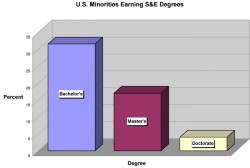Slip Sliding Away
October 10, 2008

<< Return to ‘Earth Science Revolution’…
The initiative addresses another critical need in Texas, indeed across the U.S.—the retention of minority students. As minority students advance through high school and college, at every level their numbers dwindle and the proportion of them studying science and engineering shrinks. Few go on to pursue careers in science. TXESS Revolution seeks to reverse that trend by training teachers who work predominantly in minority or underserved public schools in Texas.
A few statistics help illustrate the declining involvement of minority students in science.
According to a 2005 report by the Department of Education’s National Center for Education Statistics, Hispanic and black high school students are about as likely to take biology and geology or earth science courses as white and Asian/Pacific Islander students. Yet they are less likely to complete physics, chemistry, engineering and honors science courses than those other groups.
Hispanic and Black high school students also lag behind white and Asian/Pacific Islander students on standardized science tests. For example, in 2005 on the National Assessment of Educational Progress—an ongoing study by the Department of Education often referred to as the Nation’s Report Card—Hispanic students’ scores in advanced science averaged 13 percent lower and black students’ scores averaged 21 percent lower than those other groups.

The shift away from science continues in college.
The National Science Foundation (NSF) reports that in 2004, 31.5 percent of underrepresented minority students who were U.S. citizens and received bachelor’s degrees in the U.S. got them in science and engineering (S&E) fields. That same year, just 17 percent received master’s degrees and only 4 percent received doctoral degrees in S&E fields. Clearly, minorities who stay on for graduate degrees opt less and less for degrees in S&E fields.
The slow attrition of minorities in the sciences becomes especially apparent at the end of the education pipeline: where students enter the workforce. According to a 2008 NSF report, while underrepresented minorities make up 24 percent of the total U.S. population, they account for only 10 percent of college educated workers in S&E jobs.
“What if we showed students what they can do in the earth sciences?” said Olson. “Imagine a teacher has a student who is really good at math or science or computers. What if she said, ‘Have you considered a career in geology or petroleum engineering?’ whereas in the past, she might have said at best, ‘Have you considered biology?’”
<< Return to ‘Earth Science Revolution’…
For more information about the Jackson School contact J.B. Bird at jbird@jsg.utexas.edu, 512-232-9623.
